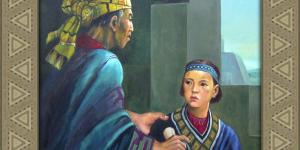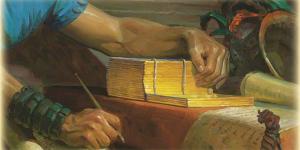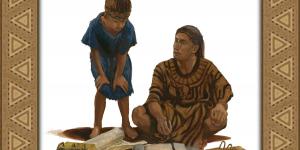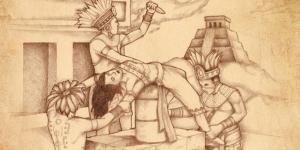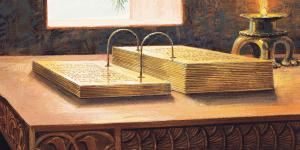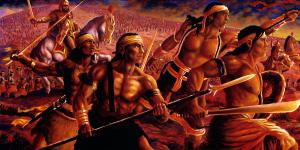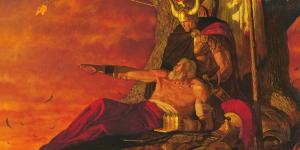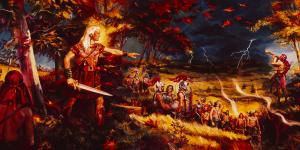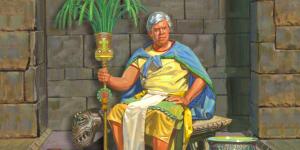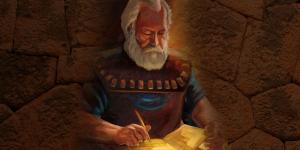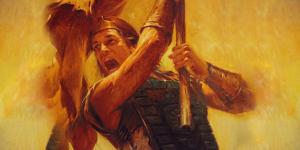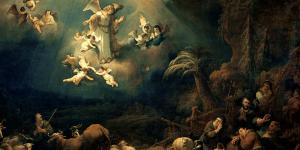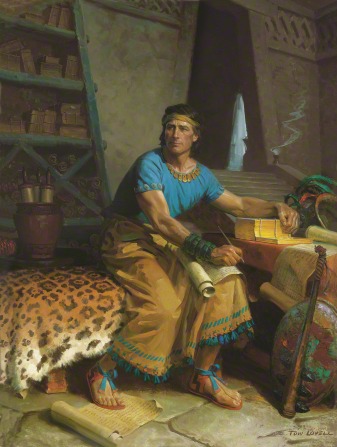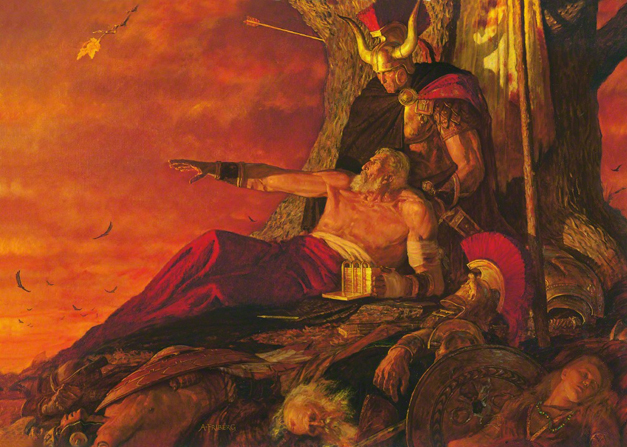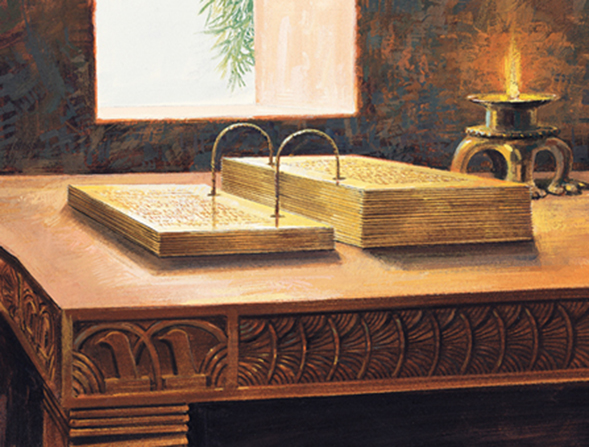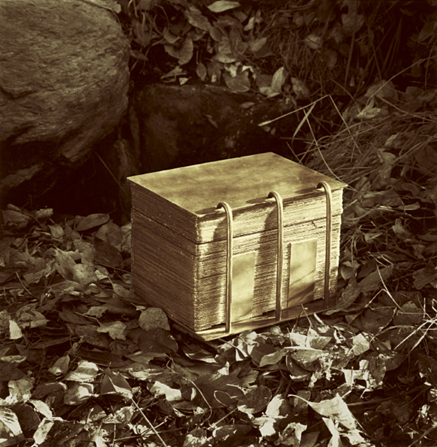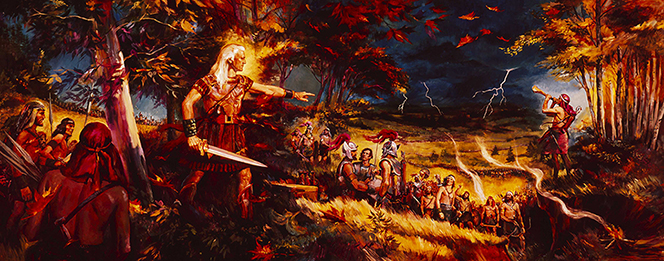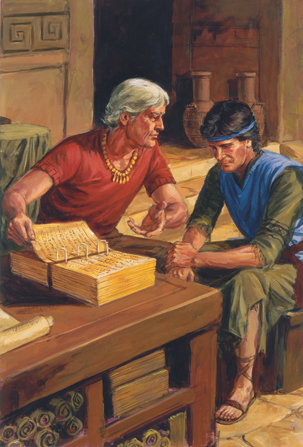You are here
Book of Mormon Central is in the process of migrating to our new Scripture Central website.
We ask for your patience during this transition. Over the coming weeks, all pages of bookofmormoncentral.org will be redirected to their corresponding page on scripturecentral.org, resulting in minimal disruption.
Gospel Doctrine Lesson #43: How Could Ye Have Departed from the Ways of the Lord?

Scripture Block
Mormon 1-6
To help class members see the importance of living according to gospel principles despite the increasing wickedness in the world.
Lesson Manual
KnoWhys

Why Is “Words Of Mormon” At The End Of The Small Plates?
Words of Mormon 1:3
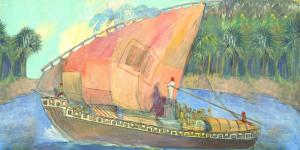
Why Did Mormon Mention Hagoth?
Alma 63:8

Why Did Mormon Introduce Himself in 3 Nephi 5?
3 Nephi 5:12
Articles
Overview of Mormon
LeBaron, E. Dale. "Ether and Mormon: Parallel Prophets of Warning and Witness." In The Book of Mormon: Fourth Nephi Through Moroni, From Zion to Destruction, edited by Monte S. Nyman and Charles D. Tate, Jr., 153-165. Provo, UT: Religious Studies Center, 1995.
This paper shows the similarities and differences of Ether and Mormon's ministries. Ether and Mormon were different in their backgrounds and situations, and similar in their missions and convictions.
Baker, LeGrand L., and Stephen D. Ricks. "Mormon’s Outline of the Book of Mormon." In Who Shall Ascend into the Hill of the Lord?: The Psalms in Israel’s Temple Worship in the Old Testament and in the Book of Mormon, 472-474. 2nd ed. Salt Lake City: Eborn Books, 2011.
This short article structures the entire outline of the Book of Mormon, in order to see Mormon's logic in abridging the Book of Mormon. Mormon redacted and organized the Book of Mormon to emphasize the importance of covenants, ordinances, and the temple in many instances.
Gardner, Brant A.. Mormon’s Editorial Method and Meta-Message In 2008 FAIR Conference. Sandy, UT: FairMormon, 2008.
Gardner seeks to provide a commentary on Mormon's life and work of the Book of Mormon. He begins by laying out what is known of Mormon's life. Then he delves into how he pieced together the Book of Mormon. He explains the outline of the Book of Mormon, reasoning behind book names, the sources behind his accounts, and how Mormon interacted with his record.
Holzapfel, Richard Neitzel. "Mormon, the Man and the Message." In The Book of Mormon: Fourth Nephi Through Moroni, From Zion to Destruction, edited by Monte S. Nyman and Charles D. Tate, Jr., 117-131. Provo, UT: Religious Studies Center, 1995.
Mormon was not only the abridger of the plates, but he was a Nephite record-keeper, a general, an apostle and prophet, a father, and he may have also been a prophetic type.
Roundy, Phyllis Ann. Mormon In Encyclopedia of Mormonism, Edited by Daniel H. Ludlow. Vol. 2. New York: Macmillan, 1992.
An encyclopedic entry on Mormon, his life, works, and the book of Mormon.
Hatch, Gary Layne. "Mormon and Moroni: Father and Son." In The Book of Mormon: Fourth Nephi Through Moroni, From Zion to Destruction, edited by Monte S. Nyman and Charles D. Tate, Jr., 105-115. Provo, UT: Religious Studies Center, 1995.
This article provides commentary on Mormon's work as a general and abridger of records. He walks through the narrative of Mormon's life and comments on Moroni's relationship with his father. Through years of work and faith, Mormon and Moroni were able to compile the magnificent record of the Book of Mormon.
Hardy, Grant. "Mormon's Agenda." In Reexploring the Book of Mormon, edited by John W. Welch, 245-247. Provo, UT: FARMS, 1992.
This short piece highlights one of Mormon's main purposes in writing this sacred record. As he demonstrates in Helaman and Mosiah, Mormon wants to show that unless the Lord afflicts his people, they will not remember Him.
Hyde, Paul Nolan. A Comprehensive Commentary of the Title Page of the Book of Mormon. Orem, UT: Parrish Press, 2015.
This volume provides extensive commentary on the Title Page of the Book of Mormon, written by the hand of Mormon. This title page serves as an introduction and preface to all that the reader encounters in the Book of Mormon, and reflects Mormon's own feelings about the work and the Gospel of Jesus Christ.
Butler, John M.. "The 'Author' and the 'Finisher' of the Book of Mormon." In The Book of Mormon: Fourth Nephi Through Moroni, From Zion to Destruction, edited by Monte S. Nyman and Charles D. Tate, Jr., 61-68. Provo, UT: Religious Studies Center, 1995.
In the Church we speak of Jesus Christ as the author and finisher of our faith (Moroni 6:4; Heb. 12:2). This paper examines and compares Mormon as an "author" and Joseph Smith as a "finisher" of the Book of Mormon. Perhaps no other prophet personifies the preparation and achievements of Joseph Smith better than the prophet Mormon. He was a type for the Prophet Joseph—foreshadowing Joseph's life and important mission.
Hardy, Grant, and Robert E. Parsons. Book of Mormon Plates and Records In Encyclopedia of Mormonism, Edited by Daniel H. Ludlow. Vol. 1. New York: Macmillan, 1992.
Encyclopedic entry on how the various records and plates are compiled to form the current Book of Mormon.
Hardy, Grant. Gold Plates In Encyclopedia of Mormonism, Edited by Daniel H. Ludlow. Vol. 2. New York: Macmillan, 1992.
This encyclopedic entry explains the contents of the gold plates, and how they came to be in their current form.
Mormon 1
Mormon 2
Mormon 3
Thomasson, Gordon C. "The Survivor and the Will to Bear Witness." In Reexploring the Book of Mormon, edited by John W. Welch, 266-268. Provo, UT: FARMS, 1992.
In an interesting and unique approach, Thomasson shows that Mormon and other Book of Mormon authors demonstrate similar human reactions to those that experience horrific traumas. Survivors of Hitler's death camps seem to react in similar ways to Book of Mormon authors, who also witnessed human atrocities and genocide.
Mormon 4
Mormon 5
Keller, Roger R.. "Mormon and Moroni as Authors and Abridgers." In Reexploring the Book of Mormon, edited by John W. Welch, 269-271. Provo, UT: FARMS, 1992.
While many view Mormon as a passive compiler in creating the Book of Mormon, this article shows the different ways that he and Moroni actively interact with the sources. They even author entire chapters throughout the Book of Mormon in providing commentary on the narrative.
Tvedtnes, John A.. ""I Make This Small Abridgment"." In The Most Correct Book: Insights from a Book of Mormon Scholar, 1-7. Salt Lake City : Cornerstone Publishing, 1999.
Through a comparison between the Book of Mormon and the Old Testament, Tvedtnes shows that the concept of abridging the records of former generations is a long-standing one in ancient Israel. Authors and redactors of the Old Testament abridged records similarly to how Mormon abridged the records in the Book of Mormon, and does not undermine the validity of the message.
Mormon 6
Bowen, Matthew L.. ""O Ye Fair Ones" - Revisited ." Interpreter: A Journal of Mormon Scripture 20 (2016): 315-344.
In the beginning of the Nephite record, Nephi extols his people for being "fair" and "beautiful." However, by the end of Nephite civilization, Mormon laments the fate of the now wicked Nephites by declaring "O ye fair ones." This demonstrates how the “unbelieving” descendants of the Nephites and Lamanites can again become the “good” and the “fair ones” by choosing to come unto Christ.
Tvedtnes, John A.. "Mormon as an Abridger of Ancient Records." In The Most Correct Book: Insights from a Book of Mormon Scholar, 8-21. Salt Lake City: Cornerstone Publishing, 1999.
Tvedtnes seeks to show that Mormon, and not Joseph Smith, was the likely author and compiler of the Book of Mormon. He does show by noting where Mormon refers back to earlier sources, how he seamlessly implements flashbacks, and how he remains consistent through his whole text.
Ricks, Stephen and John A. Tvedtnes. "Notes and Communication: The Hebrew Origin of Some Book of Mormon Place Names." Journal of Book of Mormon Studies 6, no. 2 (1997): 255-59.
The name "Cumorah" is mentioned in Mormon 6:6. Suggested etymologies range from a corruption of the biblical Gomorrah1 to a comparison with Qumran, the name of the site near the caves where the Dead Sea Scrolls were found. This article proposes that the most likely etymology comes from the Hebrew word for "priesthood."
Hedges, Andrew H. “Cumorah and the Limited Mesoamerican Theory.” Religious Educator 10, no. 2 (2009): 111–134.
From the time the Book of Mormon was published, its readers have speculated about the hill Cumorah's geographical setting. This article contains the viewpoint of Andrew Hedges, that the hill Cumorah is not necessarily located in Mesoamerica, and that the hill does not need to be located close to where the other Book of Mormon events take place.
Roper, Matthew. "Plausibility, Probability, and the Cumorah Question." Religious Educator: Perspectives on the Restored Gospel 10, no. 2 (2009): 135-158.
This paper is a response to Andrew Hedges’s “Cumorah and the Limited Mesoamerican Theory”. Roper argues that it is most plausible for the original hill Cumorah and the final battles to take place near the narrow neck of land described in the Book of Mormon.
Hedges, Andrew H.. "Problems with Probability: A Response." Religious Educator: Perspectives on the Restored Gospel 10, no. 2 (2009): 159-162.
This paper is a reply to Roper’s “Plausibility, Probability, and the Cumorah Question”. He reviews his points of agreement and disagreement with Matthew Roper, and further clarifies and defends his position.
Sperry, Sidney B. "Were There Two Cumorahs?" Journal of Book of Mormon Studies 4, no. 1 (1995): 260-68.
No one doubts that the hill where Joseph Smith received the plates is known as Cumorah, but is the hill where the final battles between the Nephites and Lamanites took place another Cumorah? The book of Ether tells us that Omer traveled to this place of the last battles of the Nephites, and that the relatively short duration of this journey would not account for the three thousand miles from Middle America to New York. A similar journey was undertaken by Limhi’s men, of equally short duration. The description of the geographical features around the final battle site is also at odds with the topography of present-day Cumorah.
Wright, H. Curtis. "Ancient Burials of Metal Documents in Stone Boxes." In By Study and Also By Faith.
This paper discusses the Mesopotamian and Ptolemaic custom of burying kings with stone boxes of metallic tablets. Although Mormon composed his record on the other side of the world, the writing of records on metal plates is attested in the archaeological record.
Welch, John W.. "Number 24." In Reexploring the Book of Mormon, edited by John W. Welch, 272-274. Provo, UT: FARMS, 1992.
Welch discusses the significance of the number twenty-four in Biblical tradition, in light of Mormon 6:16 which laments how all were slain except for twenty-four people.
Ricks, Stephen D.. "Some Notes on Book of Mormon Names." Interpreter: A Journal of Mormon Scripture 4 (2013): 155-160.
Mormon 6:14 mentions a Nephite general named "Josh." This paper discusses the possible Hebrew root for this name, not as a short for "Joshua," but as a variant of "Josiah."
Additional Lesson Guides
LDSLiving Gospel Doctrine Lesson #43
Interpreter Student and Teacher Resources Mormon 1-9
RSC Gospel Doctrine Lesson #43
Meridian Magazine Gospel Doctrine Lesson #43
John Bytheway Gospel Doctrine Prep Lesson #43
GospelDoctrine.com Mormon 1, Mormon 2, Mormon 3, Mormon 4, Mormon 5, Mormon 6
Feast Upon the Word notes on Gospel Doctrine Lesson #43
Jim Falconer's notes on Gospel Doctrine Lesson #43

